If you’re looking for the best things to do in Malaga, this complete guide will help you discover the must-see attractions of the Costa del Sol. Beyond its reputation for sun and sea, the city offers a fascinating mix of history, culture and gastronomy. Its historic center is filled with architectural treasures, its long beaches invite you to relax, and its vibrant food scene and world-class museums make Málaga one of the most exciting destinations in southern Spain.
I have to admit that, years ago, my first impression of Malaga wasn’t exactly the best. During my initial visit, I felt a bit disappointed—it almost felt like I was abroad, with so many english signs and areas clearly designed for tourists.
But as with many places, it’s often the second visit that truly reveals the magic. And it was on that second chance that I began to discover the best things to do in Malaga and understand what makes this city so special.
I had the opportunity to repeat the trip, and this time I got the thorn out of my side. We have discovered an incredible city that goes far beyond first impressions.
Uncover 20 unforgettable reasons to fall in love with Malaga. Follow our steps through the city—from hidden gems to the lively heart of its historic center—and experience it just like we did.
Best time to visit Malaga
Malaga is a wonderful destination all year round. We decided to visit in autumn to avoid the sweltering heat of summer, and, although we coincided with the onset of the famous Dana, we were lucky to enjoy excellent weather and ideal temperatures.
Spring is the perfect season to visit Malaga, with mild temperatures that make it ideal for exploring the city on foot.
If you’re planning your trip during Easter, be aware that the streets can get very crowded with processions and accommodation prices tend to rise. To avoid surprises, we recommend book your accommodation in advance.
Travel tips for visiting Malaga
To truly get to know Malaga, we recommend spending at least two days in the city. This 2-day Malaga itinerary will guide you through the most essential and unforgettable spots.
If you have more time, you can rent a car o take an excursion to explore nearby gems such as Ronda or Nerja.
We also recommend you to take a walking tour is the best way to learn about its history. In addition, we will offer you some tips on gluten free restaurants where you can enjoy local delicacies while living the Malaga experience.
Let yourself be captivated by the charm of Malaga!
Also read: Best things to see in Malaga in 3 days
A historical walk through the East of Malaga and Paseo de Reding
Malaga English Cemetery
Since we discovered the Comillas Cemetery and we were surprised with its imposing Exterminating Angel we have become true fans of the most peculiar sacred places.
If you are one of those who enjoy exploring unusual places, you can not miss the English Cemetery of Malaga, the oldest Protestant necropolis of the peninsula.
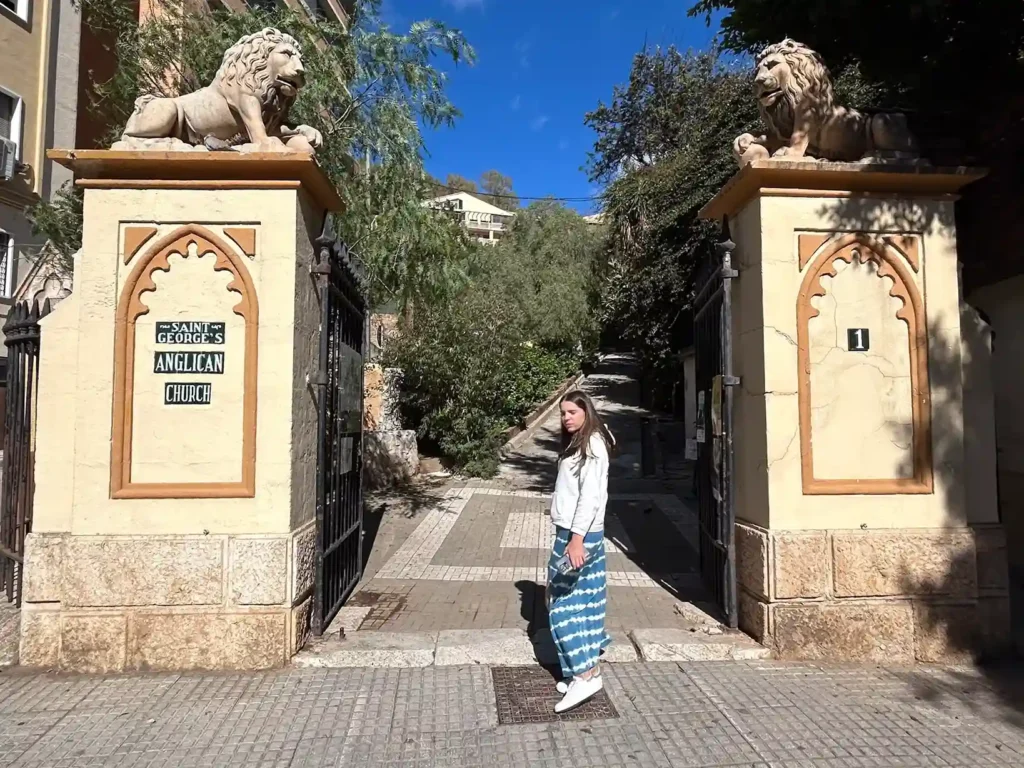
This unique tourist destination combines history, culture and nature in a unique setting. Among tombs, sepulchers and pantheons, there is a charming botanical garden full of exotic floral species.
2. Reding Promenade
Our tour begins at the English Cemetery and continues along the Reding Promenade, a scenic walkway that links the slopes of Mount Gibralfaro with the sea.
This charming route is named after Swiss military officer Theodore Reding, a celebrated hero of the Battle of Bailén during the Spanish War of Independence.
We discover imposing buildings of the bourgeoisie of the 19th century, such as the Miramar Palace, the Houses of Félix Sáenz and the Palace of La Tinta. And we also pass by tourist attractions such as the Municipal Heritage Museum.
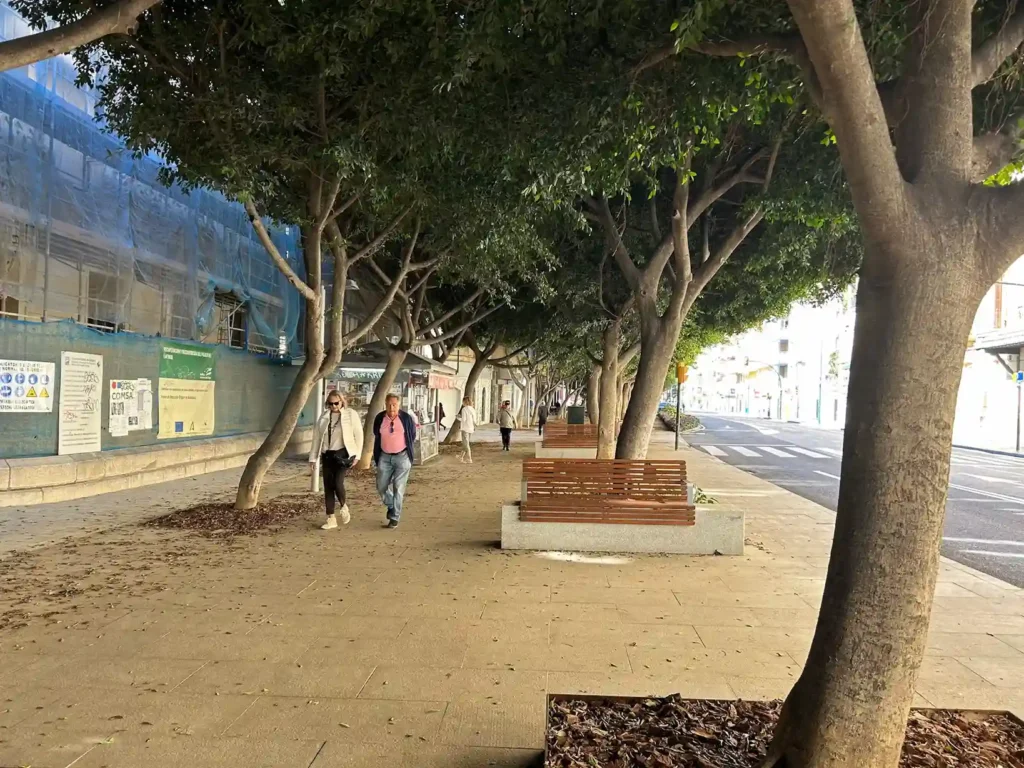
We chose to keep walking all the way up to Gibralfaro Castle, one of the top attractions in Malaga. But if you’d rather skip the uphill walk, you can hop on municipal bus No. 35 from Paseo de Reding, which takes you straight to the castle entrance.
3. Gibralfaro Castle
The Gibralfaro Castle, an impressive Arab fortress built in the 14th century, is one of the most emblematic and visited places in Malaga.
As you walk along the castle walls, flanked by eight towers, the most impressive is the 17-meter-high Torre Mayor. From the top, you’ll enjoy some of the best panoramic views of Málaga, with the Mediterranean Sea as a stunning backdrop.
In addition, the castle features two viewpoints outside its walls, perched on the Gibralfaro hill, offering breathtaking views over Malaga’s historic center. From there, you can admire the Cathedral, the port, and La Malagueta (bullring).
On clear days, the vistas stretch as far as the Rif Mountains in Africa and even the Strait of Gibraltar.
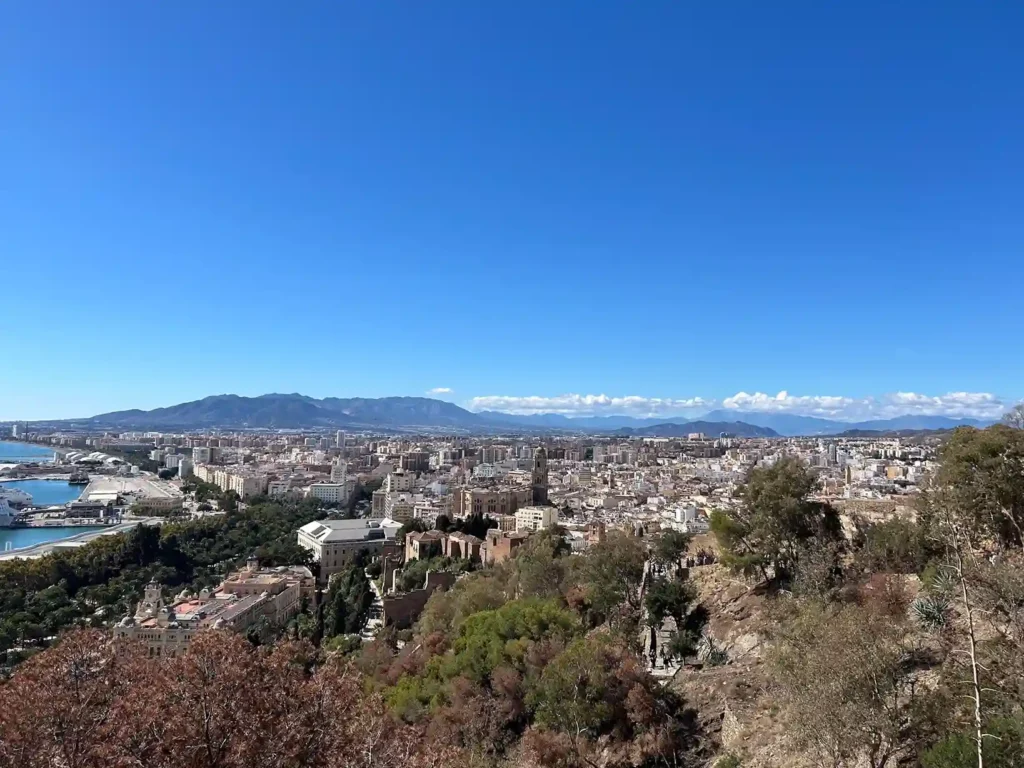
We visited the castle in the morning and were lucky enough to enjoy the music of several street musicians, who played both in one of the viewpoints and in the Alcazaba, creating an enchanting atmosphere while we explored the place.
For a deeper and more enriching experience, consider joining a guided walking tour of Gibralfaro Castle and the Alcazaba to uncover their fascinating history with the help of a local expert.
This castle, which resisted several sieges during the War of Granada, was a key piece in the defense of the city. Its image appears on the coat of arms of Malaga, granted by the Catholic Monarchs in 1494. The name of the castle comes from the ancient lighthouse that stood at the top of the mountain, which guided navigators in the Mediterranean.
The castle is located just behind the Alcazaba, with which it is connected through a corridor.
The fortress has two lines of walls and several towers, among which are the Albarrana Tower (or White Tower), which preserves an ancient cistern inside, and the Pozo de Airón, excavated in live rock with a depth of 40 meters. This well is another of the singular elements of the castle.
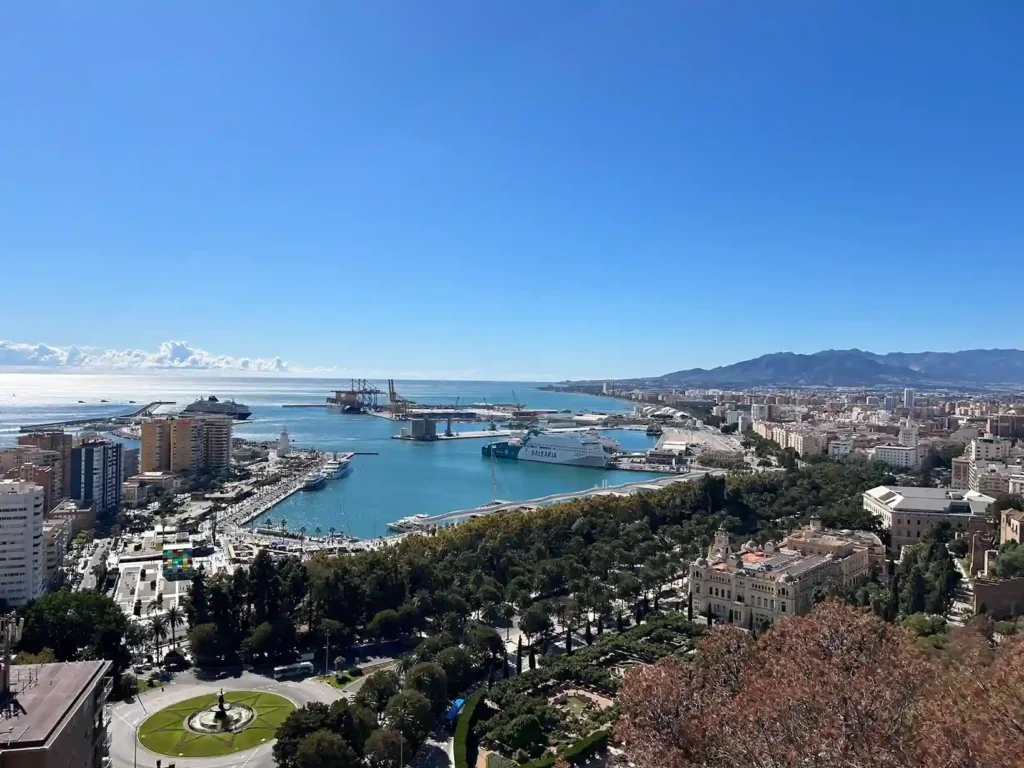
As in other castles, such as the one in Argüeso in Cantabria, Gibralfaro Castle also organizes music recitals during the summer, providing a unique cultural experience in its main courtyard, where the barracks and stables were located, offering a unique cultural experience in a historical environment.
Today, the castle is home to the Gibralfaro Interpretation Center, located in the former powder magazine. Inside, a carefully curated exhibition traces the fascinating history of the fortress, inviting visitors to step back in time and discover one of Malaga’s most iconic landmarks.
4. Bullring
The bullring of Malaga, popularly known as “La Malagueta“is one of the most emblematic monuments of the city. Inaugurated in 1876 and designed by the architect Joaquín Rucoba, it is located a few steps from the port, next to the Paseo de Reding.
Its neo-Mudejar style structure and its 16-sided floor plan make it an architectural landmark, which can be seen from the viewpoint of Gibralfaro Castle.
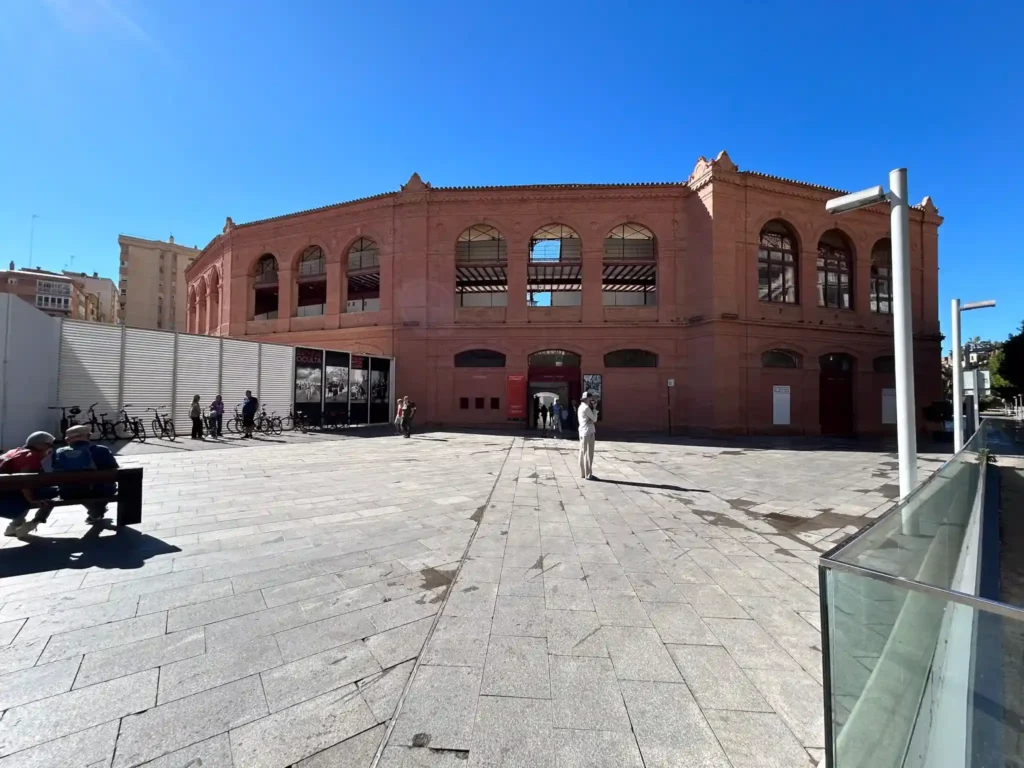
Declared Historic-Artistic Site y of Cultural Interest, La Malagueta has witnessed numerous bullfighting celebrations over the years.
After its last restoration, it houses a Bullfighting Museum which exhibits collections spanning more than six centuries of bullfighting history.
This museum allows visitors to delve into the fascinating art of bullfighting, a cultural legacy deeply rooted in Spanish tradition.
Gone are the difficult times, such as during the Civil War, which became a concentration camp for the military rebels. Today La Malagueta is a place for celebrations and events. Undoubtedly, a place full of history, art and emotions for those who visit the city.
Best Things to do in Malaga’s historic center: Culture, Architecture and Charm
5. The Alcazaba of Malaga
Located in the historic center of Malaga, at the foot of the Gibralfaro mountain, the Alcazaba is an impressive fortress that combines military, residential and aesthetic functions.
This iconic monument, whose name means “citadel” in Arabic in Arabic, stands out as one of the most important and visited places in the city, thanks to its rich history and unique beauty.

Built between 1057 and 1063, during the reign of the Taifa king Badis ben Habús, the Alcazaba was erected using materials reused from the nearby Roman Theater such as columns and capitals.
Its defensive structure, which includes a double wall, imposing towers, strategic gates and archways, made it an impregnable refuge and one of the most outstanding works of Muslim architecture in Spain.
In addition, the fortress is connected to the Gibralfaro Castle through a walled corridor known as La Coracha forming a unique monumental complex.
The interior of the Alcazaba of Malaga is a real treasure that combines the majesty of the Nasrid architecture with spaces steeped in history.
Every corner of this fortress reveals unique details that transport visitors to the Muslim era, where kings and sultans left their mark. We could not help but feel for a moment the magic of the Alhambra of Granada again.

Royal Palaces and Dependencies
The heart of the Alcazaba is constituted by the Quarters of Granada, the residence of the Taifa and later Nasrid kings.
These spaces dazzle with their detailed decoration and their connection with emblematic courtyards such as the Patio de los Naranjos with its characteristic freshness, and the Patio de los Surtidores which stands out for its central fountain surrounded by original arches from the Caliphate period.
Main Courtyard
This place, steeped in history, was the former site of artillery after the Reconquest. Here, the cannons were strategically positioned, marking an important chapter in the transition between Muslim and Christian rule.
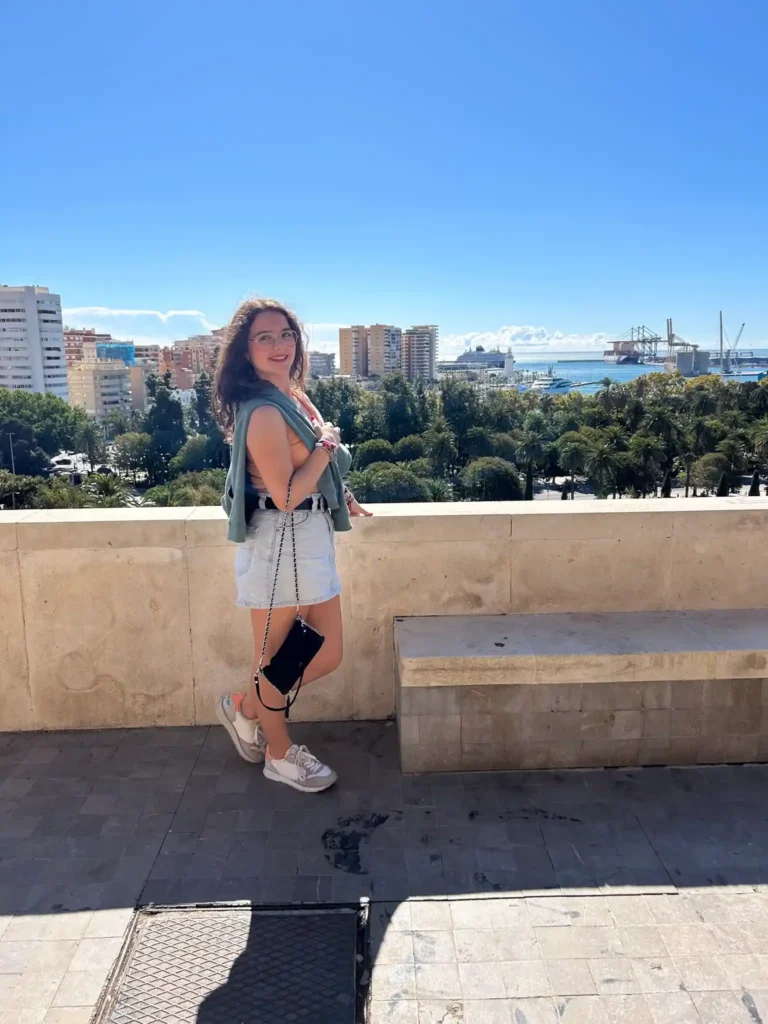
Emblematic Towers
The towers of the Alcazaba which once had important defensive functions, are today authentic lookout points with spectacular views.
Among the most outstanding are: the Tower of Homage (15th century), an imposing vestige of the Christian era; the Tower of the Vela witness of centuries of history and the Maldonado Tower recognized for its unparalleled panoramic view of the city and the Bay of Malaga.
Gardens and Ponds
The charm of the Alcazaba is amplified by its gardens full of exotic vegetation and ponds that, by reflecting the sunlight, create an atmosphere of serenity.
Designed for rest and contemplation, these spaces invite you to enjoy the tranquility while exploring the historic corners of this iconic place.
For centuries, the Alcazaba was a key fortress, resisting numerous sieges and playing a crucial role in the Reconquest. Over time, its use evolved: it housed a prison, a hospital and dwellings.
Restoration work began in the 20th century, and it was declared a Historical Heritage of Spain and, subsequently, of Cultural Interest.
Today, it is an emblem of the city’s rich cultural heritage, combining Arab, Roman and Renaissance influences. influences, combining Arab, Roman and Renaissance influences that make it a must-see destination in Malaga.
To make the most of your visit, we recommend that you join a guided tour which also includes the Roman Theater allowing you to discover every detail and secret of this fascinating place.
6. Roman Theater
Located at the base of the Alcazaba hill, the Roman Theater is one of the most emblematic monuments to see in Malaga. This vestige of the Roman period, declared a Cultural Heritage of Interest. It is surprising for its excellent state of preservation and for the historical richness it houses.
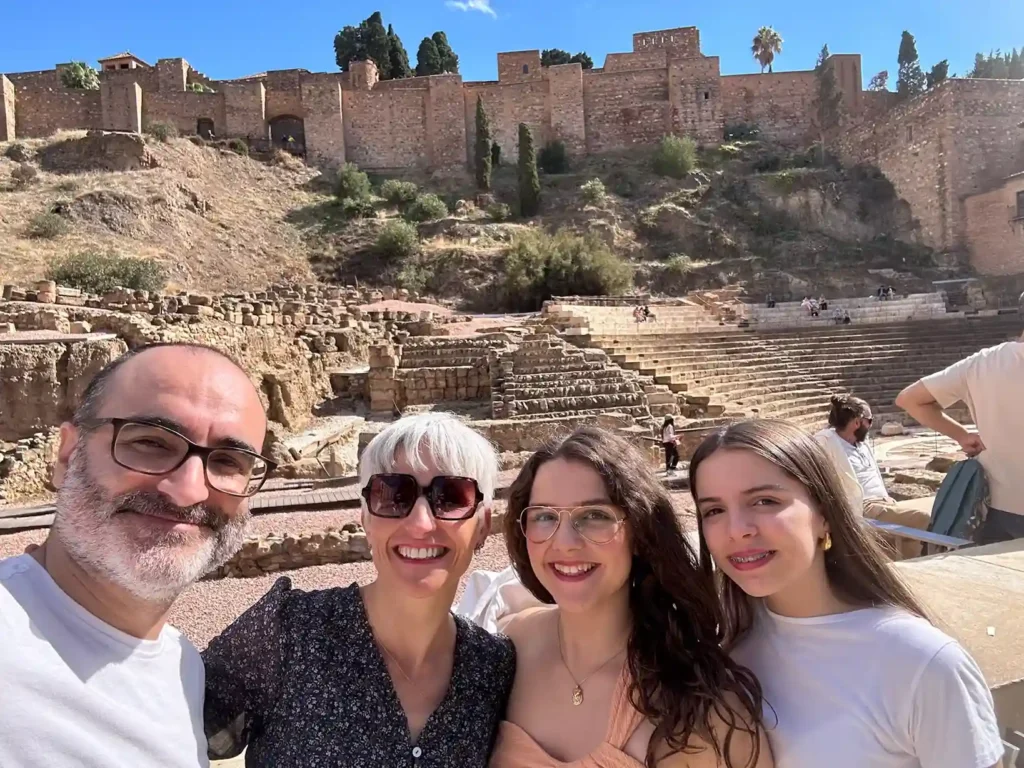
The theater preserves original elements such as the bleachers (or cavea), the orchestra and the scaena although some areas required important restorations.
Curiously, this enclosure remained hidden for centuries until, in 1951, the first remains were discovered when work was carried out on the Casa de la Cultura, a building that occupied the site.
Subsequently, it was decided to excavate the entire site, bringing to light this architectural jewel practically intact.
The Roman Theater not only stands out for its historical relevance, but also for its vibrant cultural agenda. Here are held unique events from flamenco shows to theatrical performances inspired by ancient Greece and Rome, making it a must-see destination for those who enjoy art in all its forms.
Next to the theater is the modern Interpretation Center a building made of steel, wood and glass. This space offers a fascinating virtual tour of the excavations and recreates the life and customs of Roman times. It is the perfect complement to understand the historical relevance of the site.
It should be noted that, during the Muslim period, the theater was used as a quarry to build the nearby Alcazaba, a fact that adds even more interest to its history.
7. Larios Street
Could we overlook one of the city’s most emblematic shopping streets?
Impossible! Aitana and Paola would not have allowed it.
The famous Larios Street, whose complete name is Marqués de Larios is one of the most elegant and exclusive streets in Spain, as well as being a must-see in Malaga. No wonder we walked it more than once.
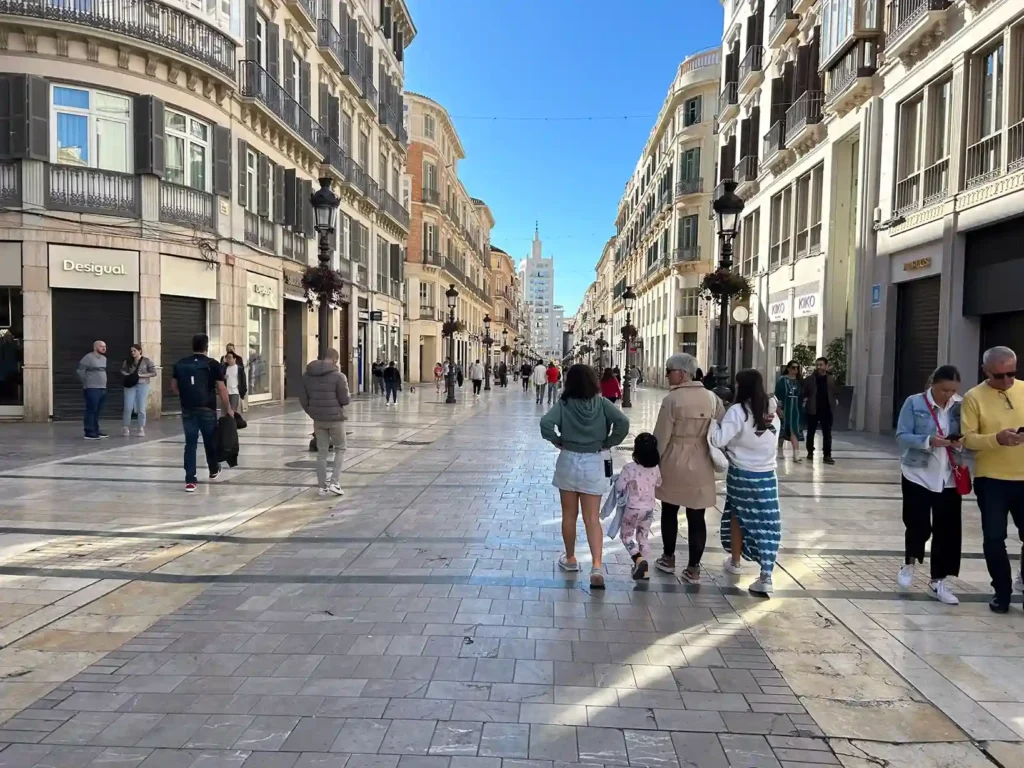
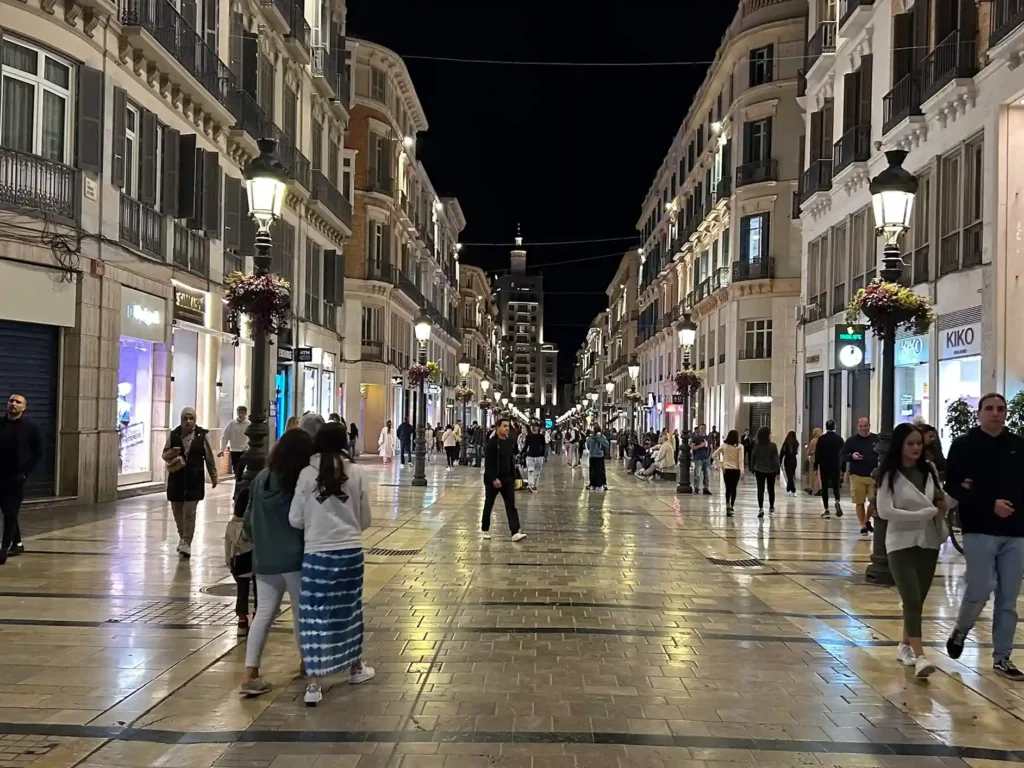
Inaugurated in 1891 and financed by the influential Larios family of Malaga, this avenue is a perfect example of 19th century urban architecture. urban architecture of the 19th century..
Its design, with symmetrical buildings with rounded corners, creates a wide and majestic promenade that attracts tourists and locals every day.
Whether to enjoy some shopping or to relax in one of its terraces, Calle Larios always offers something special.
Calle Larios not only stands out for its beauty, but also for its role in the cultural life of Malaga.
During Christmas, it is transformed into a spectacle of lights and decorations, while in August it becomes the soul of the Malaga Fair.
At any time of the year, it is a perfect place to stroll, enjoy the atmosphere and, of course, capture a selfie in one of the most photogenic corners of the city. one of the most photogenic corners of the city.
A must on any visit to Malaga!
8. Malaga Cathedral
The Cathedral of Malaga, officially known as the Holy Church Cathedral Basilica of the Incarnation is one of the most outstanding Renaissance architectural jewels of Andalusia. This imposing temple is, without a doubt, an essential place to see in Malaga.
Located in front of the baroque Bishop’s Square, its construction began in 1525 and lasted until 1782. Originally a mosque, it was transformed into a Christian temple, preserving historical details that enrich its heritage value.
Nicknamed La Manquita (The One-Armed Lady), Málaga’s cathedral earned this name due to budget constraints that left several parts incomplete—most notably the south tower, the main sacristy, and parts of the roof. Ironically, it’s precisely this unfinished aspect that has turned into one of its most iconic and beloved features.
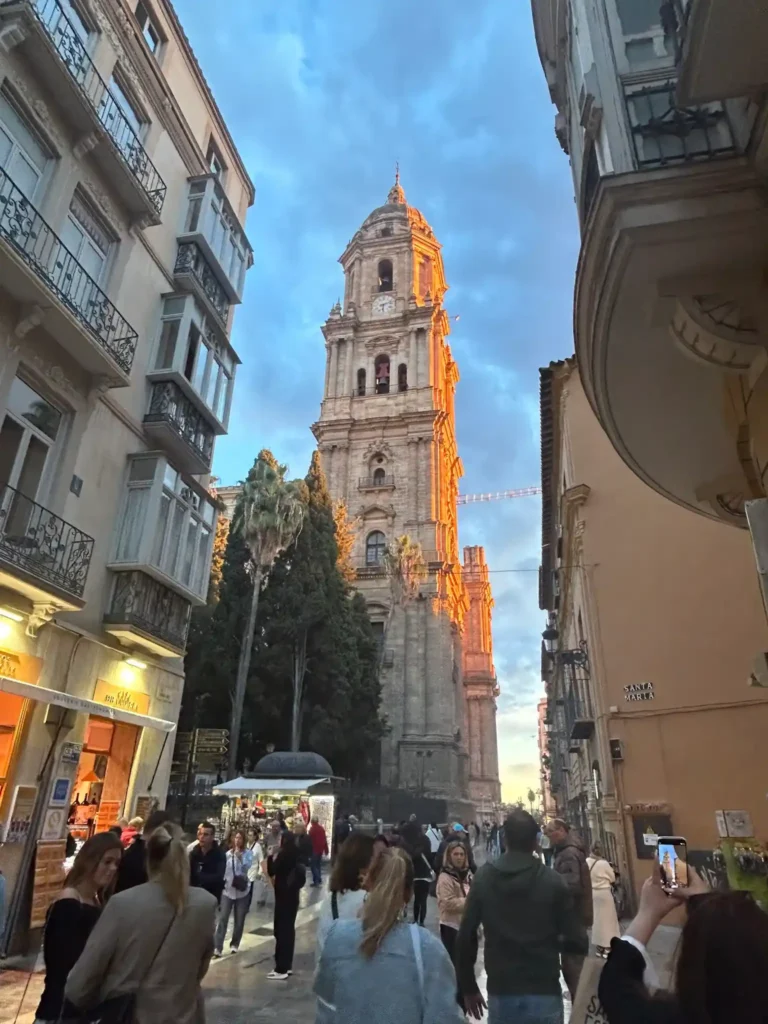
Inside, the cathedral houses authentic masterpieces, such as the High Altar and the choir stalls created by the famous Pedro de Mena. The original layout of the basilica was designed by Diego de Siloé who dedicated his talent to honoring the Virgin of the Incarnation.
They say that the terrace of the Hotel AC Palacio Málaga offers spectacular views of the cathedral, but, let’s be honest, we had a luxurious seat from our apartment. And don’t worry if you can’t get too close: the majestic figure of the cathedral looms imposingly from just about anywhere in the city – don’t miss it!
9. Episcopal Palace of Malaga
In the charming Plaza del Obispo, right in front of the imposing Cathedral of Malaga, stands the Episcopal Palace — a baroque architectural gem from the mid-18th century that also houses the Diocesan Museum of Sacred Art, making it a must-visit for art and culture lovers. And yet, despite walking past it countless times, Manuel didn’t take a single photo of this beautiful building.
Beyond its striking façade and historical significance, it houses the Diocesan Museum of Sacred Art, making it a must-visit for lovers of art and culture.
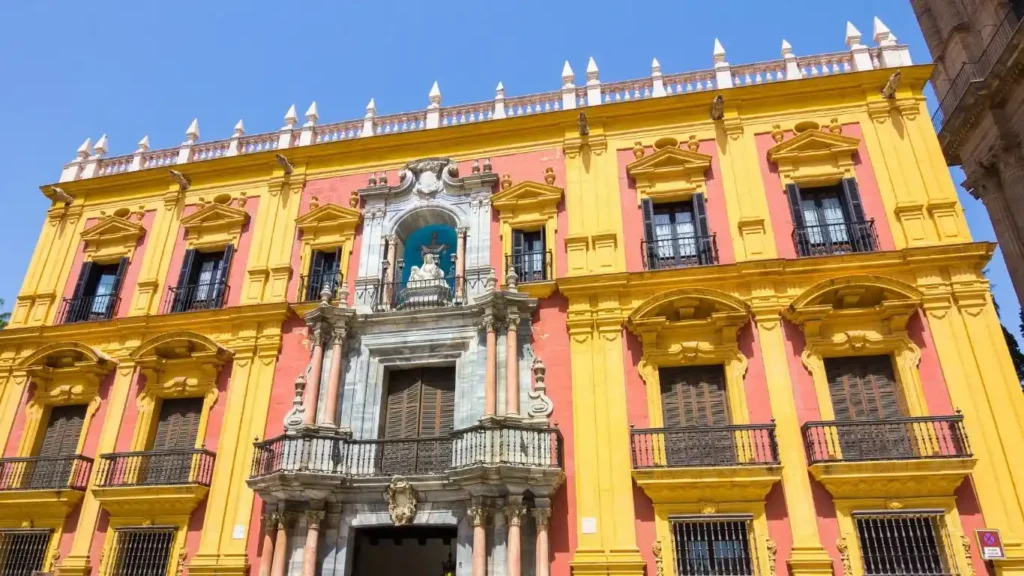
The façade of the Episcopal Palace is a spectacle in itself, standing out for its vivid ochre tones that contrast with the white details and for the delicate image of the Virgen de las Angustias that presides over it.
10. Picasso Museum
In the heart of Malaga, in the historic Buenavista Palace is the Picasso Museum a must for art lovers. This emblematic space, located in the birthplace of the great painter, pays tribute to his legacy through an impressive collection that reflects his inexhaustible creativity and experimentation.
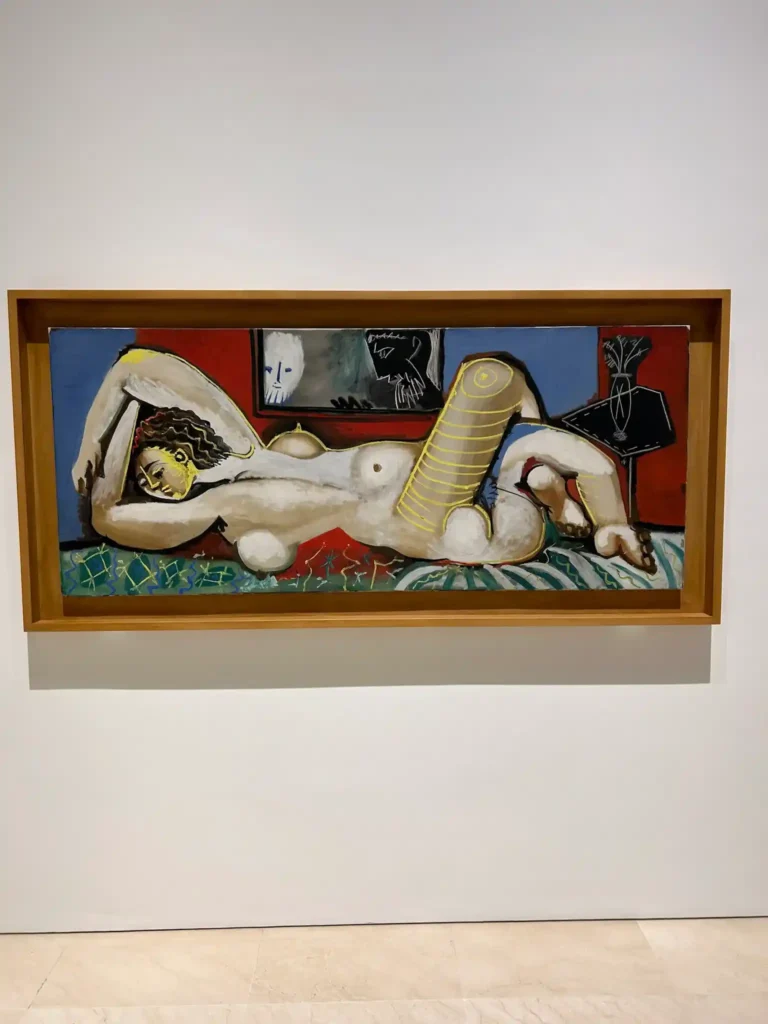
The Picasso Museum not only stands out for its valuable collection, but also for the environment that houses it. This Renaissance palace of the XVI century with its architecture of classical lines and Mudejar elements, creates a unique setting to enjoy the master’s works.
Under its wooden coffered ceilings, Picasso’s paintings, sculptures and ceramics paintings, sculptures and ceramics by Picasso come to life, while paintings, sculptures and ceramics come to life, while in the basement you can explore archaeological remains from the Phoenician and Roman eras can be explored.
The museum’s permanent collection, the fruit of the generosity of Christine and Bernard Ruiz-Picasso, daughter-in-law and grandson of the painter, fulfills Picasso’s dream of seeing his works exhibited in his native land.
Through more than eight decades of creation, visitors can appreciate the evolution of the artist, from his first experiments to the consolidation of revolutionary techniques such as cubism.
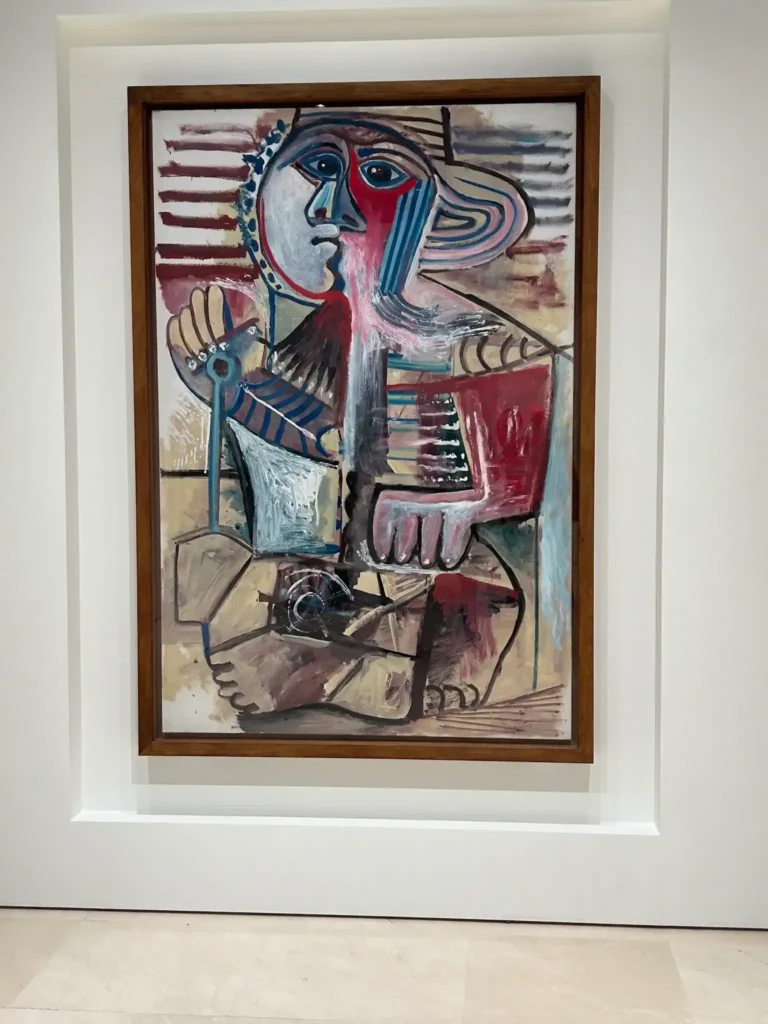
The Picasso Museum does not limit itself to displaying the creations of the author of Guernica.
Through temporary exhibitions, it establishes a dialogue with other key figures of the avant-garde, enriching the cultural experience.
In addition, the museum’s courtyard, with its Arab-inspired fountain surrounded by bougainvillea and orange trees, offers a corner of tranquility amidst the hustle and bustle of the city.
If you wish to delve deeper into the life and work of Picasso, a guided tour with an art expert is an excellent option.
If you prefer to explore on your own as we did, you can purchase tickets in advance purchase tickets in advance to avoid queues and to avoid queues and make the most of your visit.
11. Plaza de la Merced
The Plaza de la Merced, formerly known as the Market Square is one of the most emblematic corners of Malaga.
This unique space, surrounded by some of the most historic buildings of the city, has a very special connection with the Malaga painter Pablo Picasso, since this is the house where he was born and lived until 1884.
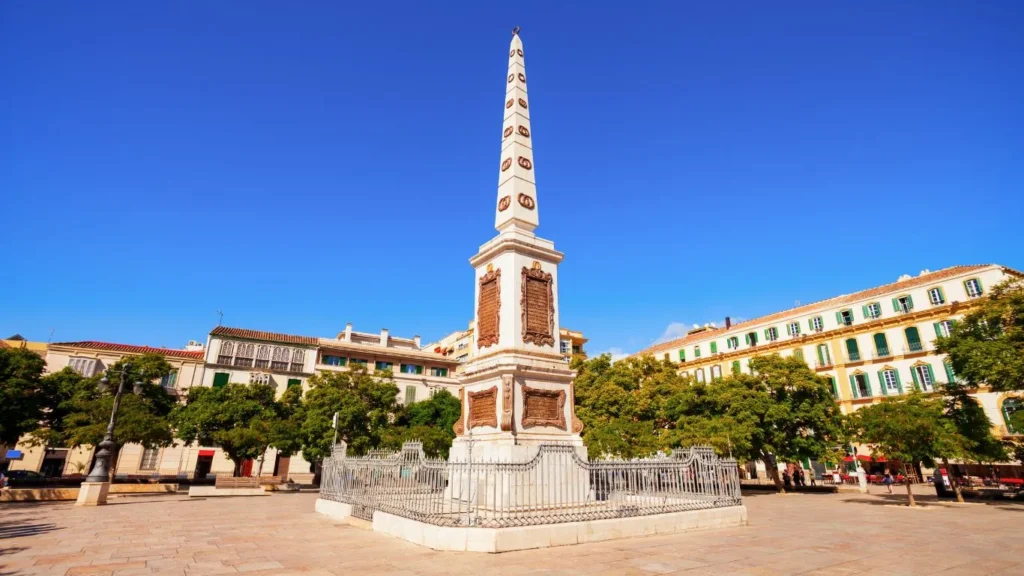
The square is a rectangle surrounded by houses and palaces that have witnessed the most important moments in the history of Malaga. In addition to Picasso, in this place lived important characters such as General Riego, the writer Juan José Relosillas, the sculptor Fernando Ortiz, the painter Bernardo Ferrándiz and the architect Gerónimo Cuervo, among others, who left their mark on the cultural life of the city.
Originally, the Plaza de la Merced was a public market during the fifteenth century, becoming a meeting place for the bourgeoisie of Malaga during the nineteenth century. This change of function reflects the social and cultural transformation that the city has undergone over the centuries.
A symbol of this era is the monolith that stands at the center of the square, erected in 1842 in honor of General Torrijos and his 48 companions, who were executed on San Andrés Beach in 1831. Although we passed near the square a couple of times, we never actually went in, so we don’t have any photos of this monument, which remains one of the square’s main landmarks.
A few meters away from the Plaza de la Merced, the Cervantes Theater stands as another of the cultural emblems of the city. Inaugurated in 1870, this theater is the main venue for the Malaga Film Festival which makes the square an important center for cultural and artistic activities.
12. Constitution Square
The Plaza de la Constitución (Constitution Square), located at the end of the famous Calle Larios (Larios Street), is one of the most emblematic points of Malaga and an essential place to see.
Since the 15th century, it has been a nerve center of Malaga life, and we have stepped on it as many times as Calle Larios itself, or even more.
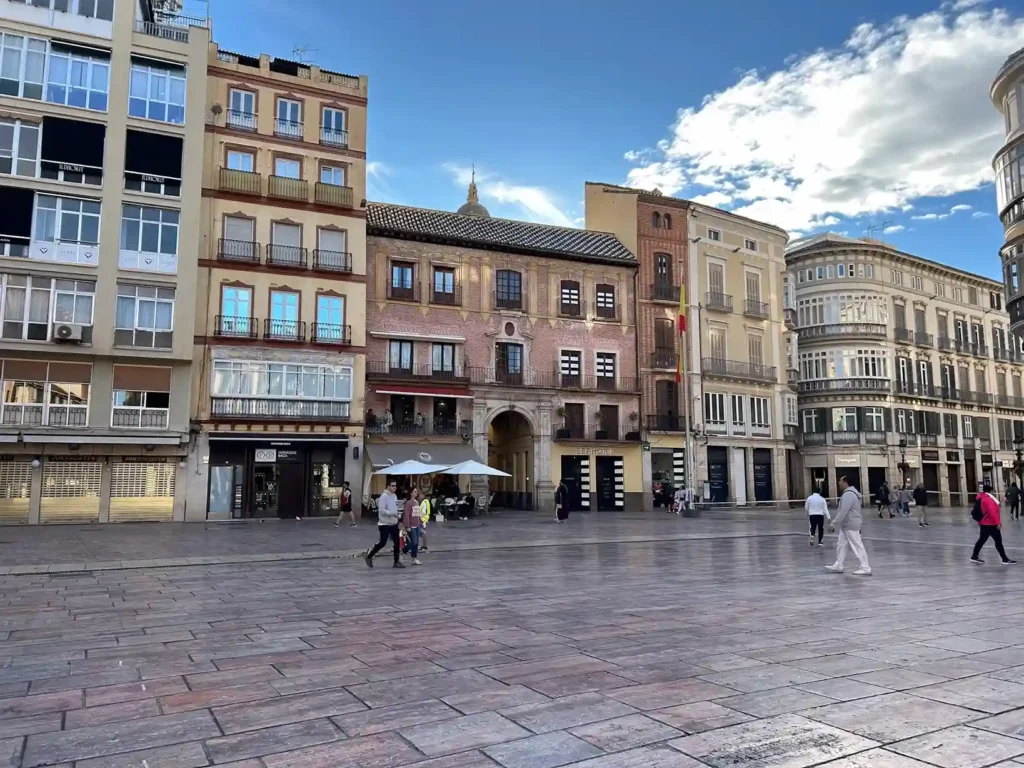
Surrounded by historical monuments such as the San Telmo School and the Consulate House, this square stands out because of the majestic Fountain of Genoa built in marble in the XVI century.
Its privileged location allows access in a few minutes to iconic places of the city, such as the Cathedral, the Roman Theater and the Alcazaba, which makes it an ideal meeting point for tourists.
Throughout its history, the square has received various names, but it was after the promulgation of the Constitution of Cadiz in 1812 when it adopted its current name. For more than 500 years, this space has housed key institutions such as the Malaga City Hall, the Casa del Corregidor, the old jail and the Audiencia.
A sales clerk at a nearby store told us that one of the main attractions of the Plaza de la Constitución are the events and celebrations it hosts throughout the year.
The Malaga Fair with its “casetas” in August, and the traditional twelve grapes on New Year’s Eve are just some of the festivities that take place in this emblematic space.
Over time, the square has seen various transformations, including the demolition of the Convent of the Discalced Augustinians and the addition of commercial arcades like the Heredia Passage and the Chinitas Passage.
Today, Plaza de la Constitución remains a vibrant and historic hub that captures the true essence of Malaga.
13. Carmen Thyssen Museum
Just a few steps from the Plaza de la Constitución, on Calle Compañía, you will find the Carmen Thyssen Museum, inaugurated in 2011.
This museum is home to one of the most important collections of Spanish Spanish painting from the 19th and early 20th centuries..
Housed in the 16th-century Villalón Palace, the museum showcases over 250 works from the personal collection of Carmen Thyssen-Bornemisza, featuring notable pieces like Saint Marina by Francisco de Zurbarán and La Buenaventura by Julio Romero de Torres.
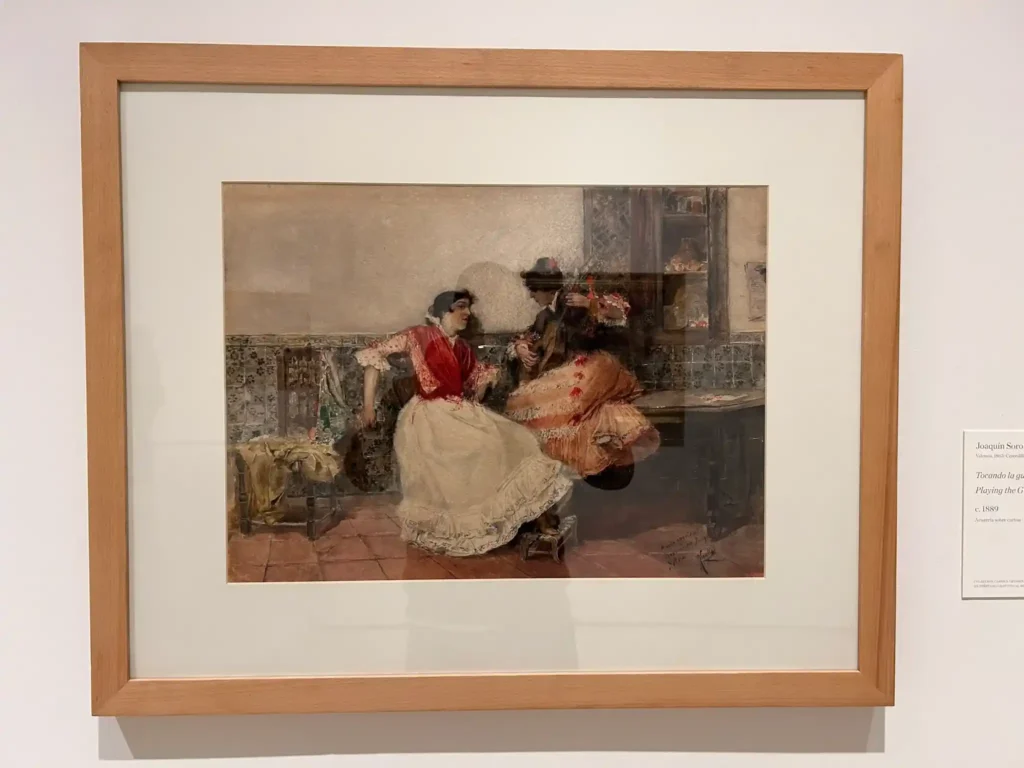
The Villalón residence is an excellent example of Renaissance Renaissance civil architecture built between the 15th and 16th centuries, which was carefully restored to transform it into an exhibition space.
The museum’s collection is organized into four thematic sections. The first, dedicated to the old masters includes works ranging from the thirteenth century to the eighteenth century, with a strong presence of religious art, being Saint Marina by Zurbarán as one of the most outstanding pieces.
The second section explores the romantic landscape and costumbrismo showing the idealized vision of Spain by the romantic travelers of the 19th century.
The third section focuses on preciosismo and and naturalist painting, while the last part while the last part is dedicated to the fin de siècle with works by artists such as Ramón Casas, Joaquín Sorolla, Mariano Fortuny and Julio Romero de Torres.
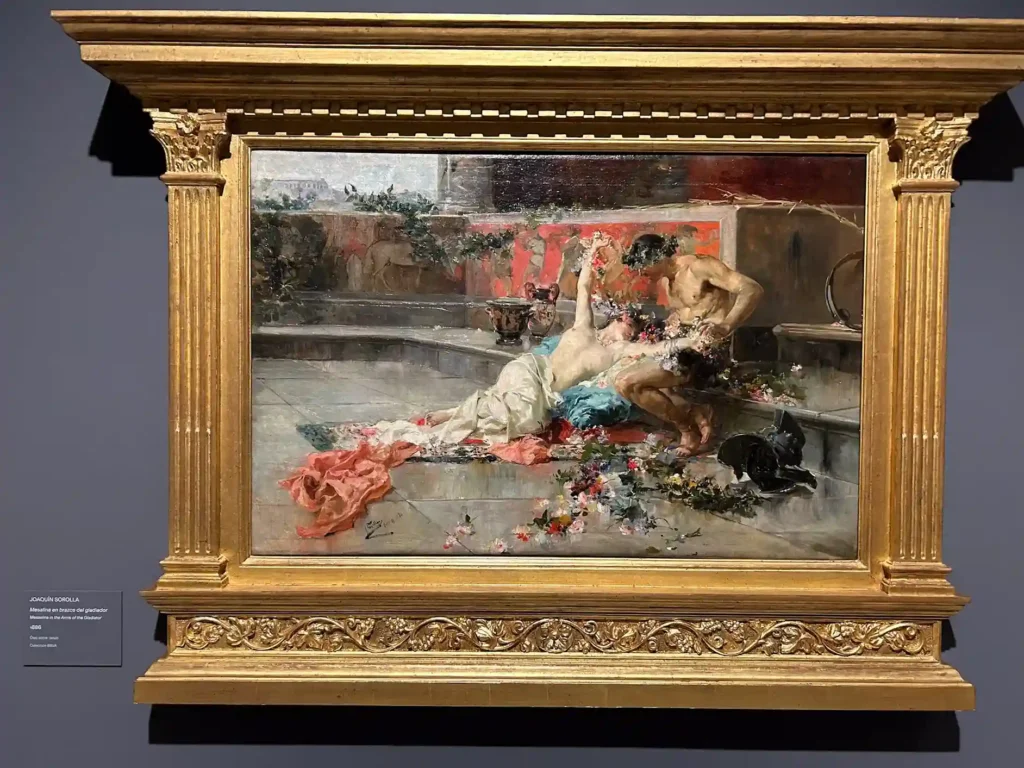
The museum also has a charming souvenir store that we recommend you to visit. Here you can find original souvenirs, art books and children’s games perfect for introducing children to the world of art.
Undoubtedly, the Carmen Thyssen Museum is an essential stop on your tour of Malaga.
You can buy your tickets to the museum here, or if you prefer a more personalized experience, book a private guided tour and explore its masterpieces with an expert.
Top seaside attractions in Malaga: beaches, port, promenade and culture
14. Malaga Park
In the heart of the city, Malaga Park is a green space of great historical and natural value.
A true oasis with an impressive diversity of vegetation including tropical and subtropical species, as well as palm trees, dragon trees, oriental plane trees and ficus that create a unique and refreshing environment.
Over the years, the park has enriched its planting with species from different parts of the world, which has earned it recognition as one of the best open subtropical gardens in Europe.
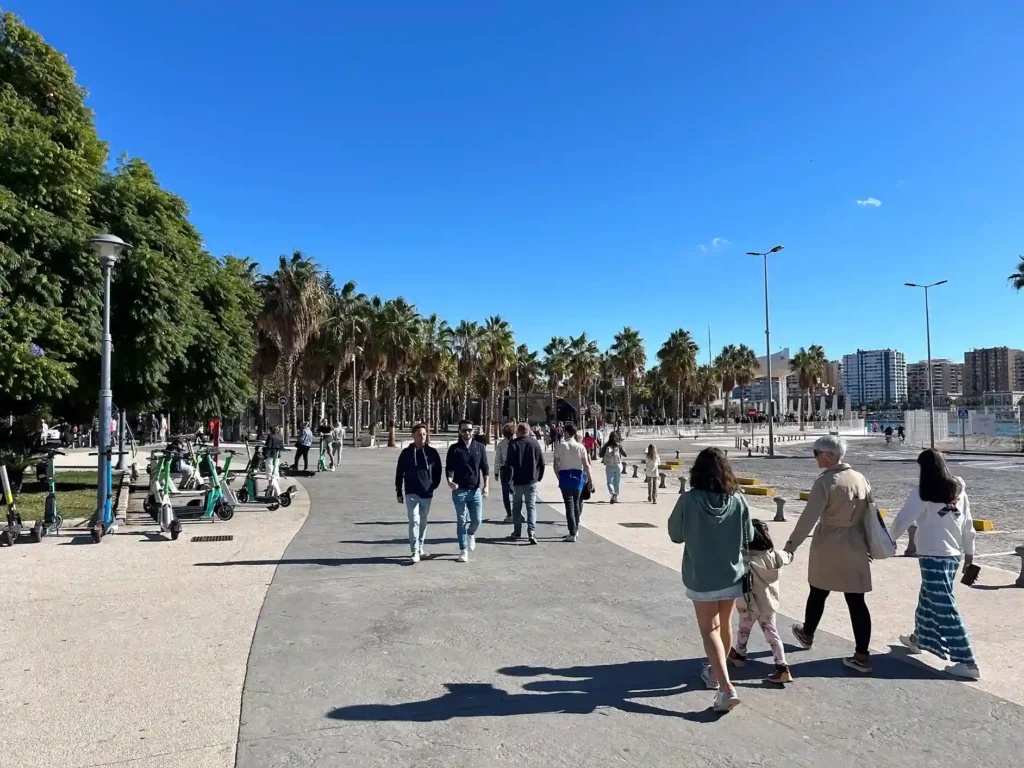
Malaga Park offers much more than nature. Its numerous monuments and fountains turn a walk along its paths into a cultural and relaxing experience.
In addition, its proximity to the famous “Palmeral de las Sorpresas” makes it a must for those who wish to explore the charm of the city.
If you are a lover of green spaces, Malaga has more corners that will make you fall in love.
- Garden of Pedro Luis Alonso: This beautiful place combines Hispano-Arabic gardening with a modern touch. Its orange trees and rose bushes will captivate you while you enjoy a quiet walk.
- Dark Gate Gardens: Located on the slopes of the Alcazaba, these gardens offer spectacular views of the city and a serene atmosphere that invites contemplation.
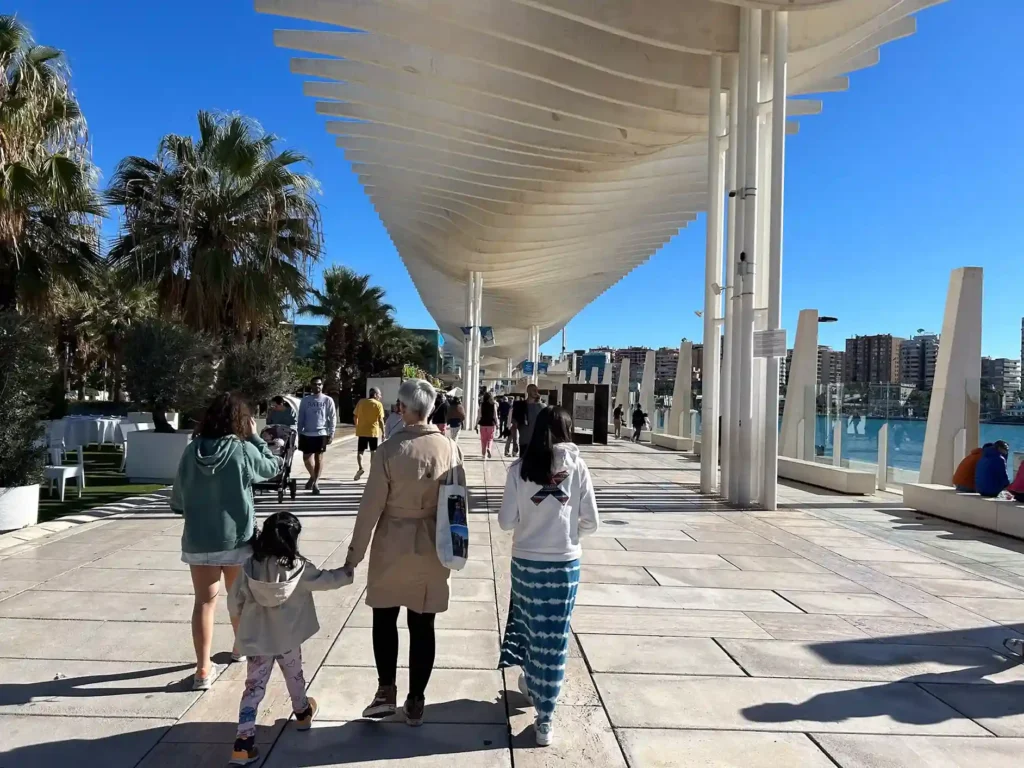
We have remained with the desire to know the Botanical-Historical Garden La Concepcion, a little more than 6 kilometers from the center of Malaga.
This extraordinary corner is known for its collection of tropical and subtropical plants, as well as offering a unique environment to disconnect and connect with nature, so stay tuned for our next trip!
15. Stroll through the Port of Malaga
With the arrival of the 21st century, Malaga recovered its port and transformed it into a space designed for the enjoyment of citizens and visitors.
Beyond its traditional commercial activity and passenger transportation, the city opened up to the sea, turning the port into a perfect place to stroll, enjoy the gastronomy, go shopping, explore art and practice sports.
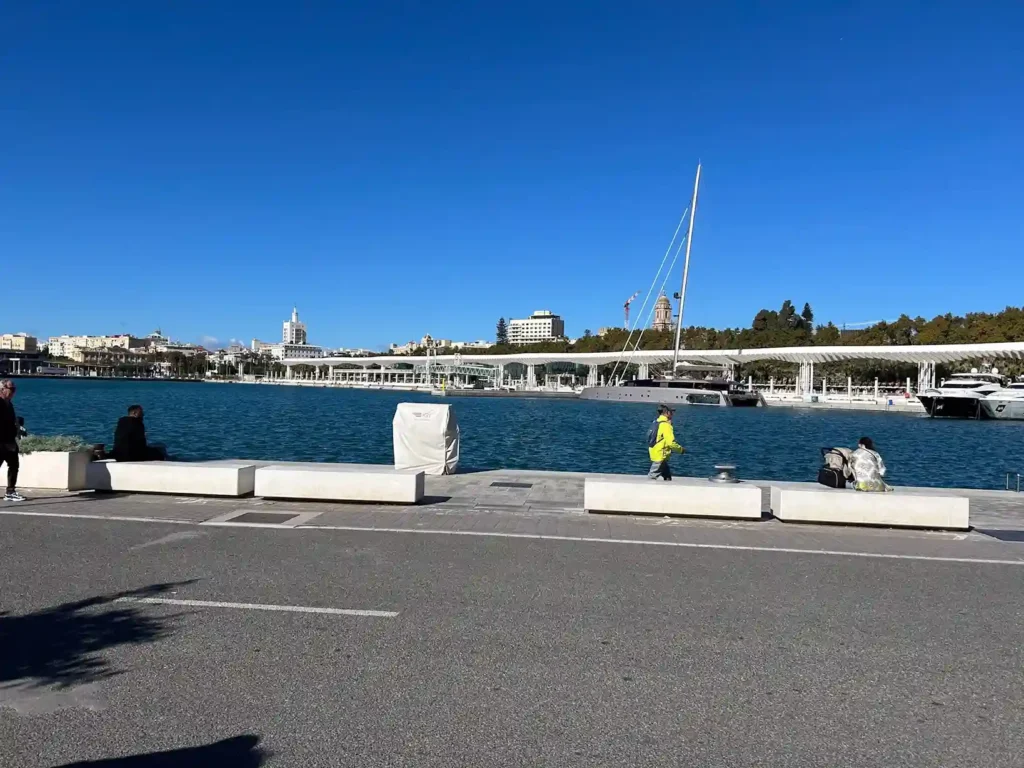
The renovation began with the redesign of Pier 1 and the Palmeral de las Sorpresas followed by the opening of Pier 2 and, more recently, the Heredia Pier located next to the artistic SoHo neighborhood.
Although they say that the best time to visit the port of Malaga is at sunset, we toured it on a sunny October morning, enjoying the beautiful views of the bay and the impressive yachts moored there. Although we live in Santander, where we also enjoy the sea, we were amazed by the luxury of these vessels.
If you’d rather enjoy the experience from the water, we suggest booking a catamaran tour along the Málaga coastline—an ideal way to admire the city from a whole new perspective.
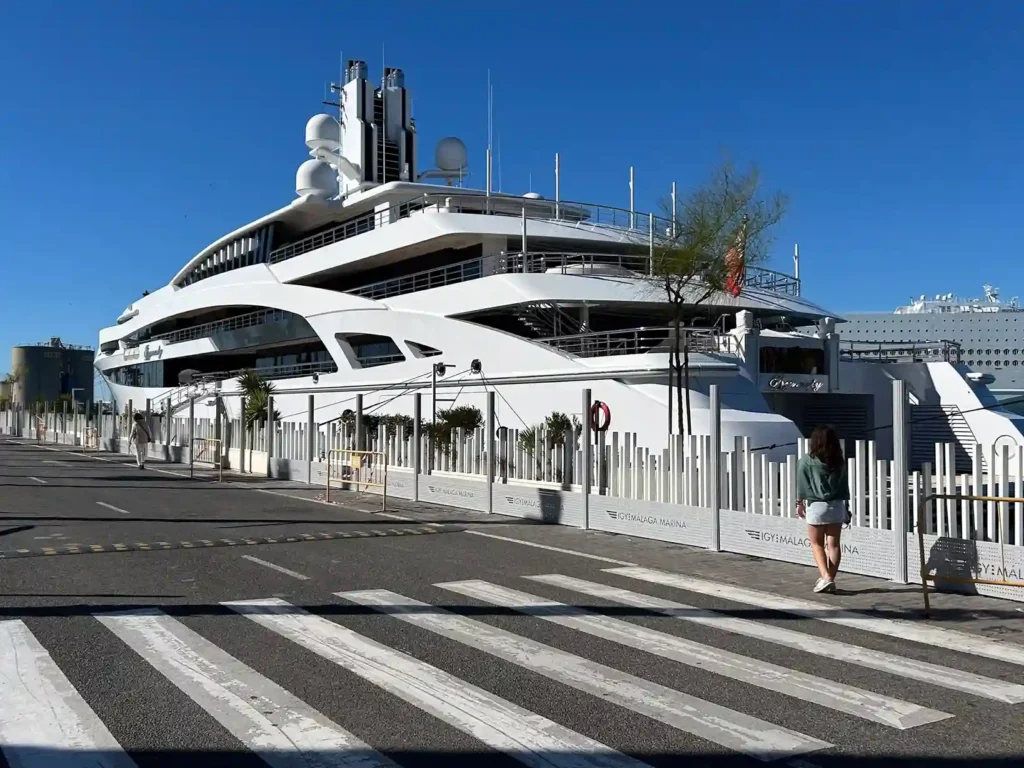
The Malaga Promenade, officially known as Antonio Banderas Promenade is one of the favorite places of the people of Malaga. This route of 2.5 kilometers covers the entire length of the Misericordia Beach and is ideal for walking, jogging or simply enjoying the coastal environment.
- To the east: the promenade becomes the Antonio Machado Promenade.
- Heading west, the Paseo Marítimo comes to an end at the Espigón de la Térmica, a historic site that once housed Málaga’s old thermal power plant. What was once used to cool the plant with seawater has now been transformed into a vibrant contemporary art space. Surrounded by old chimneys and remnants of the city’s industrial past, visitors can enjoy exhibitions, workshops, and cultural events inspired by today’s most cutting-edge artistic trends.
The Mercy Beach owes its name to a former hospice dedicated to charity, known as the House of Mercywhich was active until 1978. Since 2012, this area has evolved to become a key cultural space in Malaga.
16. La Farola
Next to the well-known Muelle 1 (pier 1), you will find the Paseo de la Farola. A place full of charm that has become one of the essential places to see in Malaga.
This promenade not only stands out for its beauty, but also for housing one of the most curious lighthouses in Spain: La Farola de Málaga.
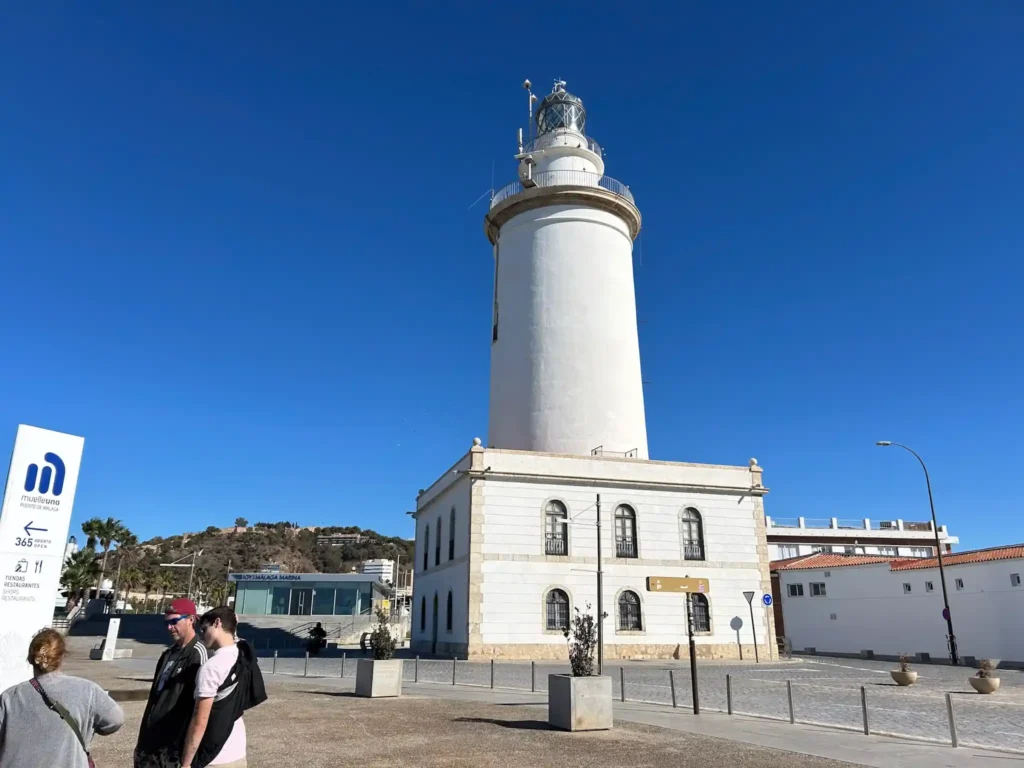
In the whole country, there are only two lighthouses with a female name. One is this emblem of Malaga, and the other one is The Farola del Mar located in the port of Santa Cruz de Tenerife.
La Farola is not only a historical and architectural landmark, but also a symbol that connects the city with its seafaring essence. Its stamp, unmistakable against the Mediterranean horizon, offers an unforgettable image both for locals and for those who visit Malaga for the first time.
17. Malagueta Beach
After enjoying the walk along the lively Muelle 1, we arrived at the famous Malagueta beach, a must-see in Malaga.
Although we are used to the urban beaches of Santander, we enjoy more than a dozen, we understand why both locals and tourists consider it a luxury to have more than a kilometer of sandy beach perfectly equipped for family recreation.
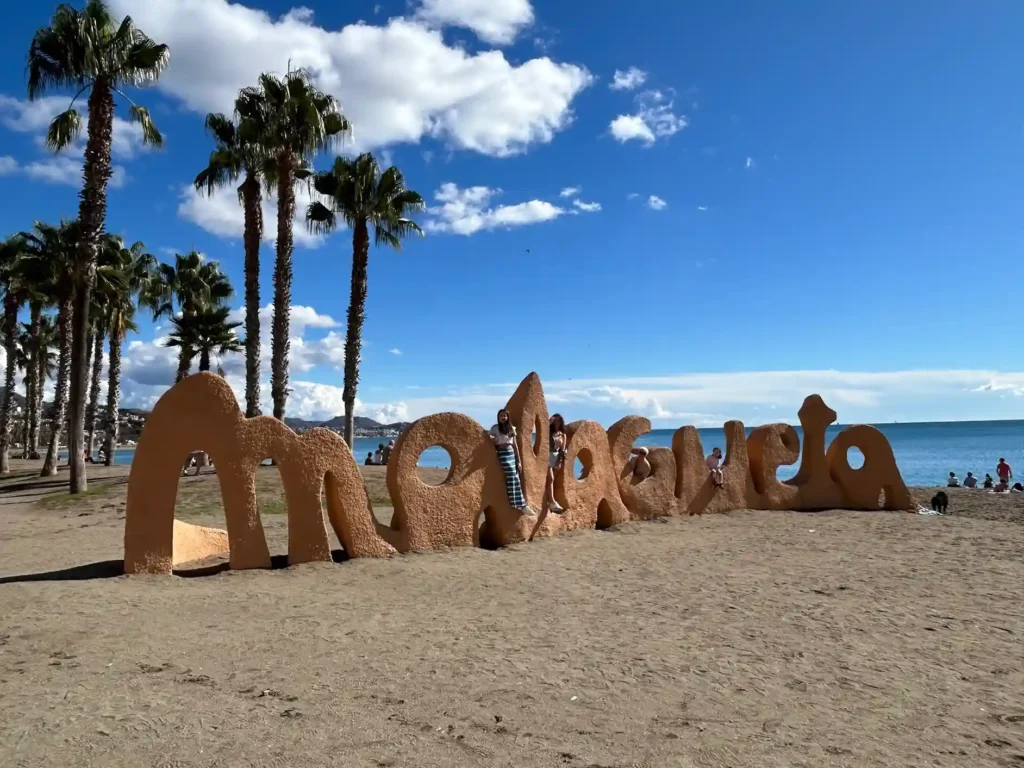
What today is a modern and accessible destination, in the past was an enclave of fishermen and an industrial area. Today, the Malagueta has been transformed into a space with all the services you may need: restaurants, hammocks, showers, restrooms, children’s play areas and even water sports equipment rental.
If at some point you find Malagueta too crowded, don’t hesitate to explore its neighbor, La Caleta beach, which also offers similar amenities.
And if you are looking for a wilder experience, the coasts of the province of Malaga have less urban beaches full of magic that will surprise you.
18. Pompidou Center
Among the revitalized spaces in Malaga’s port area, the Centre Pompidou stands out as a cultural gem. Housed in its iconic multicolored glass cube, it’s a must-visit for contemporary art enthusiasts and one of the city’s top museums.
Located between Pier 1 and Pier 2, this museum has become a cultural reference since its inauguration in 2015 as the first international headquarters of the prestigious Georges Pompidou National Center for Art and Culture in Paris.
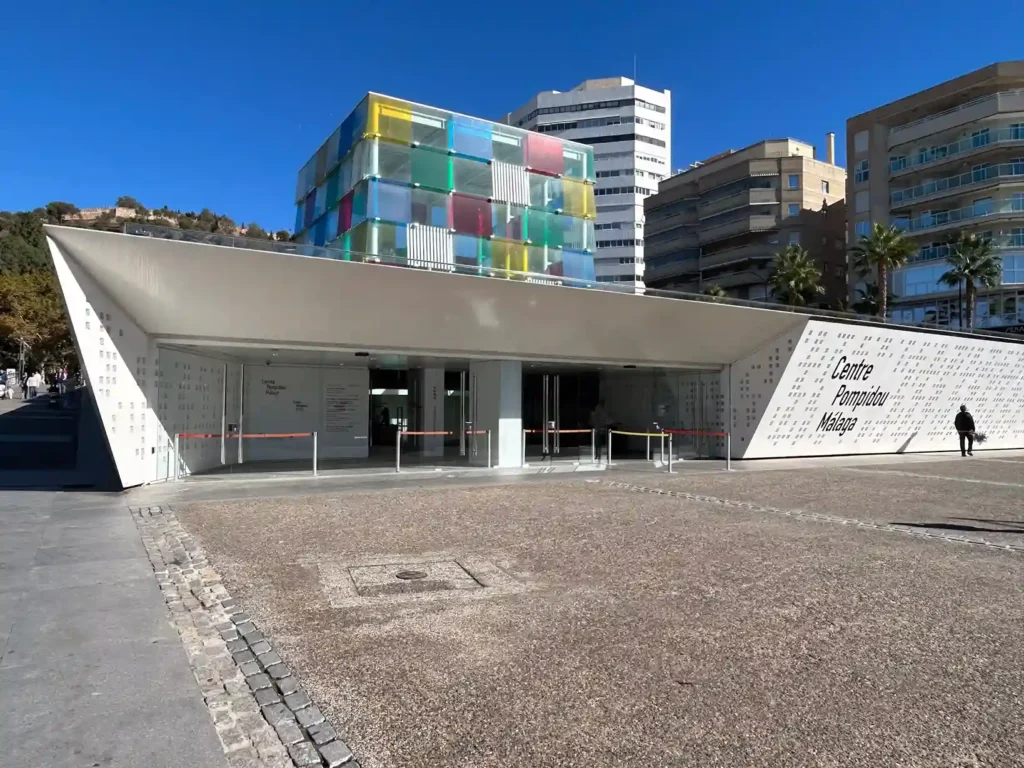
We could not miss in our album the distinctive multicolored glass cube that crowns the building is undoubtedly one of the most photographed points of Malaga.
However, its charm does not end on the outside. As you descend its artistically designed staircase, you immerse yourself in a 6,300-square-meter space dedicated to contemporary art.
Inside, you’ll discover an impressive collection featuring masterpieces by renowned artists such as Pablo Picasso, Joan Miró, Salvador Dalí, and Kandinsky. The museum also hosts top-tier temporary exhibitions, brought directly from the Centre Pompidou in Paris.
The Pompidou Centre in Malaga not only focuses on exhibiting great pieces of art, but also on bringing culture to all kinds of audiences. It has a Young Public Space, a free access room specially designed for children between 6 and 12 years old, where interactive exhibitions-workshops are held.
In addition, the museum offers free admission days on special dates, such as:
- The White Night (a Saturday in May).
- The International Museum Day (May 18).
- The World Tourism Day (September 27).
If you plan to visit Malaga, you cannot leave without discovering this amazing museum. We recommend you book your tickets in advance to avoid queues and ensure a complete cultural experience.
The modern and vibrant side of Malaga: flavors and art in Soho
19. Atarazanas Market
On our way to a delicious breakfast with gluten-free churros, we discovered the Central Market of Malaga known as Mercado de Atarazanas. This place is much more than a simple market: it is a space full of history, culture and flavor.
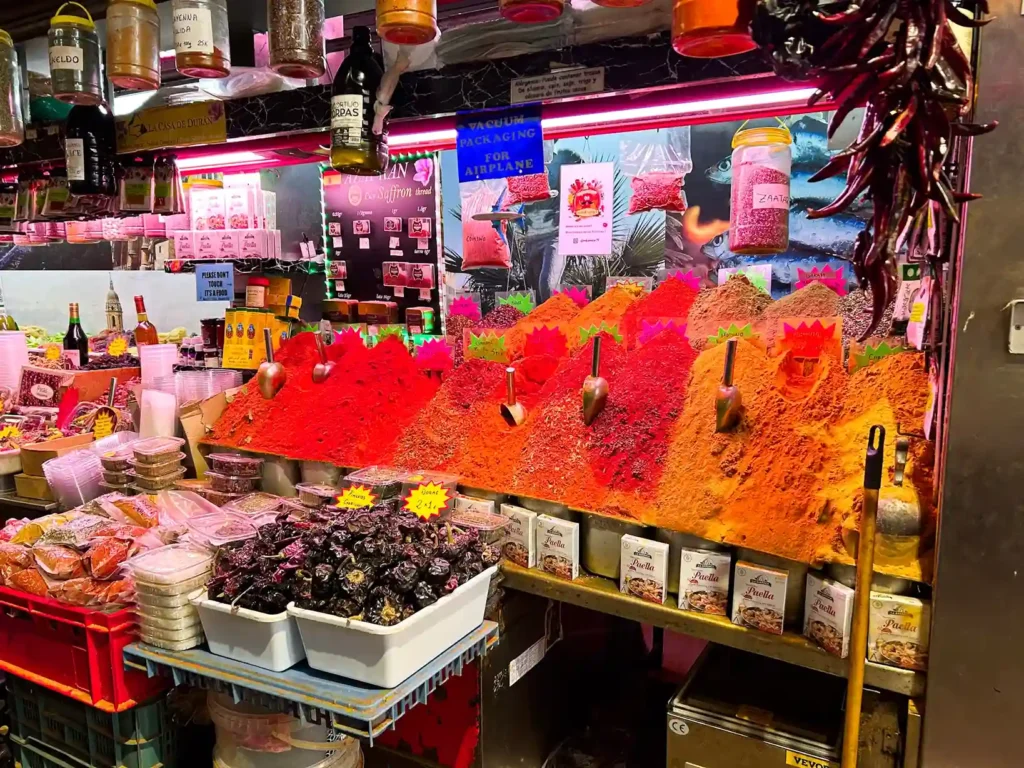
Its name has Arabic roots, as "atarazanas" means "place where ships are repaired", a reference to its origin in the 14th century, when the building housed the city's shipyards during the Muslim era. In the 19th century, after the conquest of Malaga and the demolition of the city walls, it was Joaquín Rucaba who rebuilt the building with an innovative design.
Today, the Atarazanas Market is a vibrant indoor market that combines tradition and modernity. It is divided into two main areas:
- Supply area: Here you will find a wide selection of fresh and quality products, such as fruits and vegetables, fish and seafood, meats, sausages, offal, pickles and salted meats. It is the ideal place for food lovers looking for authentic ingredients.
- Bars and tapas: The reform of the market has incorporated bars and stalls where you can taste tapas made with the freshest products. In addition, its outdoor terraces offer a perfect place to enjoy the atmosphere of Malaga while enjoying a tapa and a glass of wine.
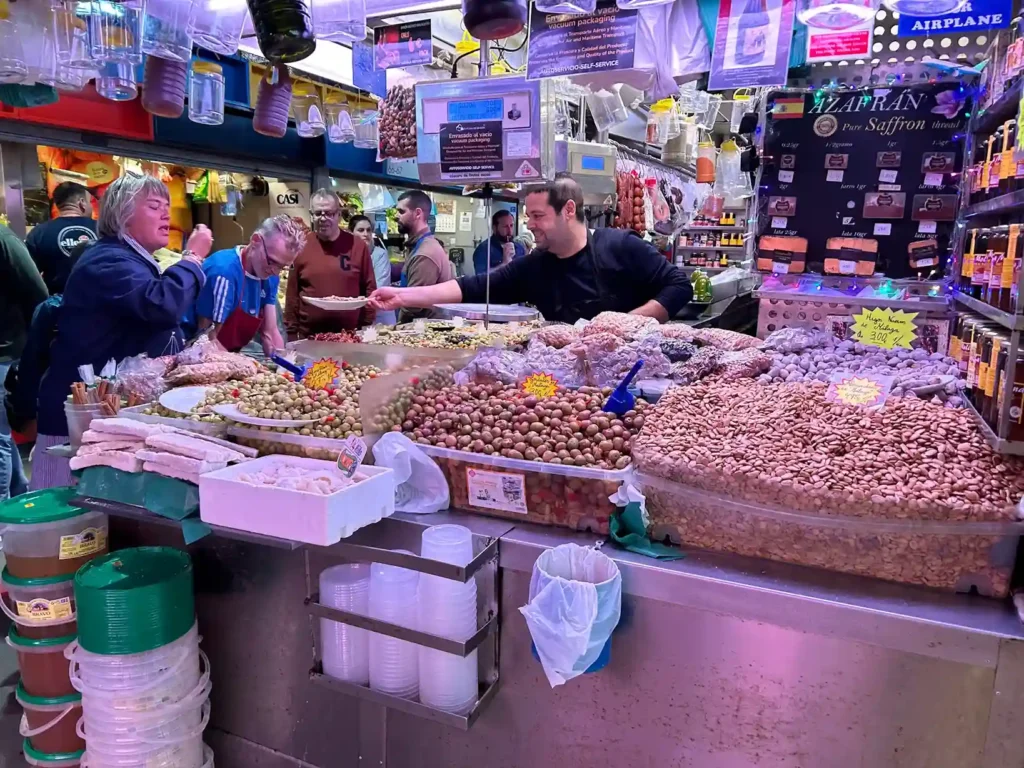
One element that does not go unnoticed is the spectacular stained glass window located on the façade opposite the central portico. This work of art depicts the port of Malaga and the city in the sixteenth century, adding a cultural touch to the experience.
20. Soho neighborhood
SoHo, known as the Barrio de las Artes, is one of the most bohemian and fashionable areas to see in Malaga. This neighborhood, which covers about 20 hectares between the Alameda Principal and the Muelle Heredia, has become a cultural and artistic reference of the city.
In its streets you can admire impressive graffiti by renowned urban artists. The most outstanding works can be found around the Contemporary Art Center of Malaga (CAC Malaga) and in the streets Barroso, Casas de Campo and Trinidad Grund.
In addition, the neighborhood is home to key cultural points such as the CAC Malaga the Soho Theater (owned by Malaga actor Antonio Banderas), art galleries, design stores, alternative stores, stylish bars and restaurants.
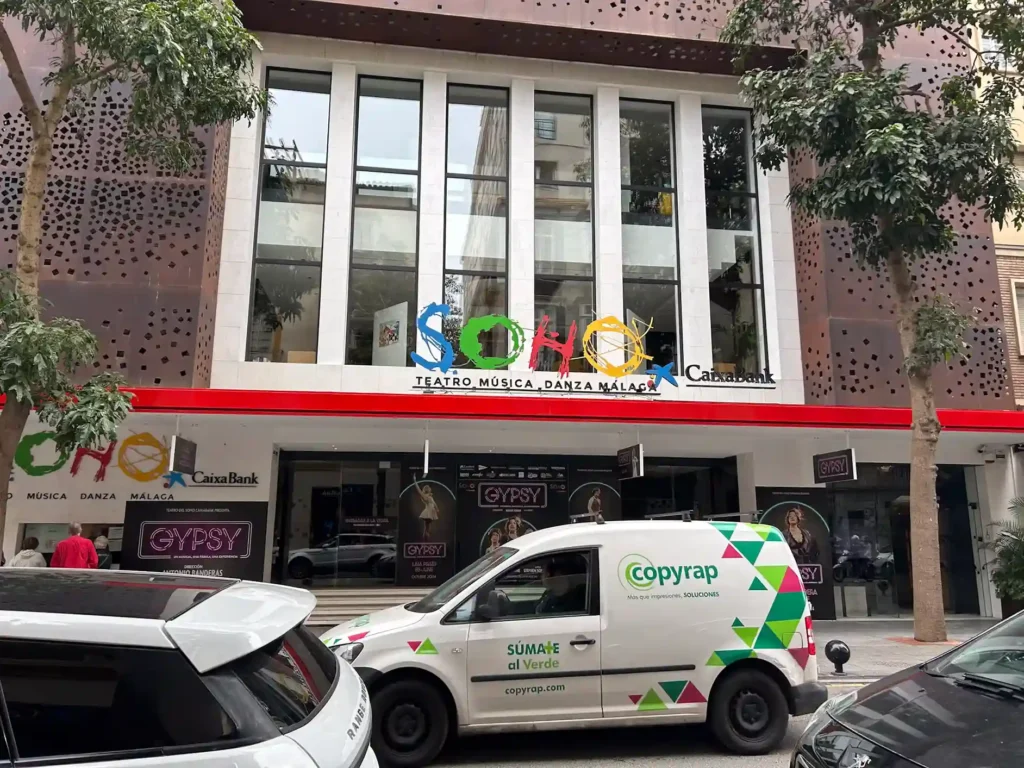
We couldn’t leave Malaga without visiting SoHo. This neighborhood surprised us with its unique energy, its combination of urban art and cultural spaces, and its alternative atmosphere that makes it a must-see in the city.
The SoHo is also the epicenter of the cultural project MAUS (Málaga Arte Urbano Soho)an initiative that seeks to transform the neighborhood into a huge canvas where the best street art artists in the world can capture their creations.
Malaga at Christmas: Lights on Calle Larios and the Giant Christmas Tree
We haven’t experienced Christmas in Málaga ourselves yet, but during our visit a city hall employee encouraged us to come back in December, explaining how magical the city becomes during the holidays. She especially recommended seeing the giant Christmas tree in Plaza de la Constitución, one of the city’s most iconic landmarks at this time of year. The tree, often walkable inside, has become a favorite photo spot for locals and visitors alike.
Beyond the tree, Málaga dazzles with the Christmas lights on Calle Larios, famous across Spain for their spectacular light-and-music shows. Add to this the Christmas market at Paseo del Parque, traditional nativity scenes such as the one at the City Hall, and open-air concerts, and it’s easy to understand why Málaga is considered one of the most enchanting Christmas destinations in southern Europe.
An unforgettable trip with a Malaga flavor
Malaga is not only a city full of history, art and beauty, but it also offers an incredible gastronomic offer for all tastes, including gluten-free options.
During our visit, we were lucky enough to discover several gluten-free restaurants that allowed us to enjoy Malaga’s delicious cuisine without any worries.
As soon as you have the opportunity to read our post about Gluten-free Malaga you will be able to find more details about these places that, without a doubt, perfectly complement the experience of exploring this wonderful city.
Ready to discover the best things to do in Malaga while enjoying its charm and gluten-free gastronomy? Join the Glutendtrotters on this adventure and get inspired for your next worry-free getaway.
Don’t forget to leave us a comment with your favorite spots or questions — we love hearing from fellow travelers!
Frequently Asked Questions (FAQ)
As in many big cities, there are many things to see and do in Malaga. I am going to provide you with a list of the must-sees in Malaga, but you will surely tell me, after your visit, that you had left out this or another place. Here goes the list:
- Larios Street.
- Cathedral of Malaga.
- Roman Theater of Malaga.
- Picasso Museum.
- Carmen Thyssen Museum.
- The Alcazaba.
- The Malagueta beach.
- The Plaza de la Constitución.
- Malaga seafront promenade.
- Plaza de la Merced.
- La Farola.
- Atarazanas Market.
- Soho neighborhood.
For me these are the must-see places in Malaga. If you want to add any more, do not hesitate to let me know.
I don’t know if it is the most beautiful but it is the most visited and known: Calle Larios (Larios Street). Almost any time of the year you will see that this street is very busy.
The most famous market is the Mercado de Atarazanas. Be very patient because many people go to see the market. Nearby there are many bars and restaurants where you can have a drink and even eat. Unfortunately, we don’t know of any celiac-friendly restaurants in the area.
Spring and autumn offer mild weather and fewer crowds. Summer is ideal for the beach but can be hot, while winters are generally mild. We visited Malaga in autumn.
The city center is best explored on foot. For longer distances, use EMT buses, the metro for some routes, bikes or e-scooters. The Cercanías train connects Malaga with the airport and Costa del Sol towns.
